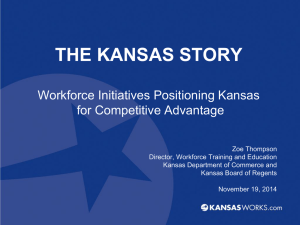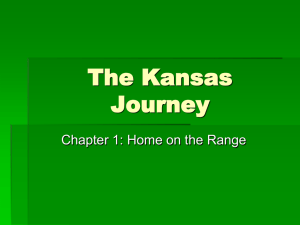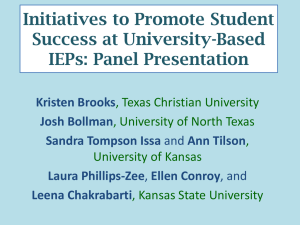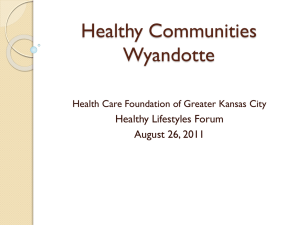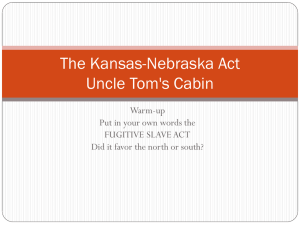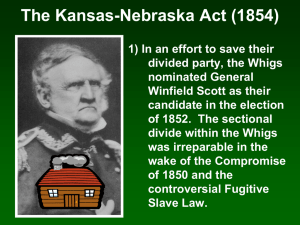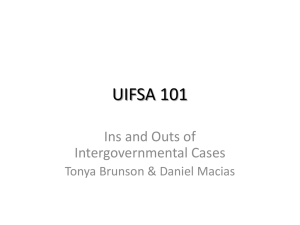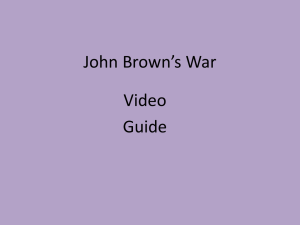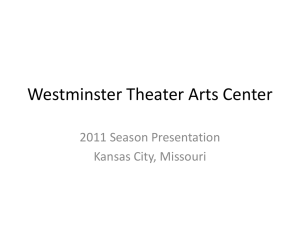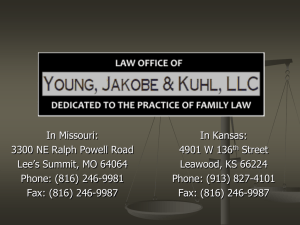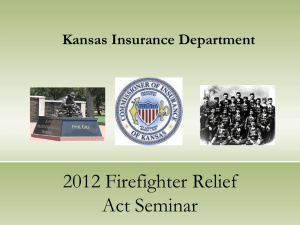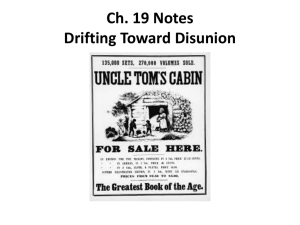Ad Astra Per Aspera: Kansas Becomes a State
advertisement
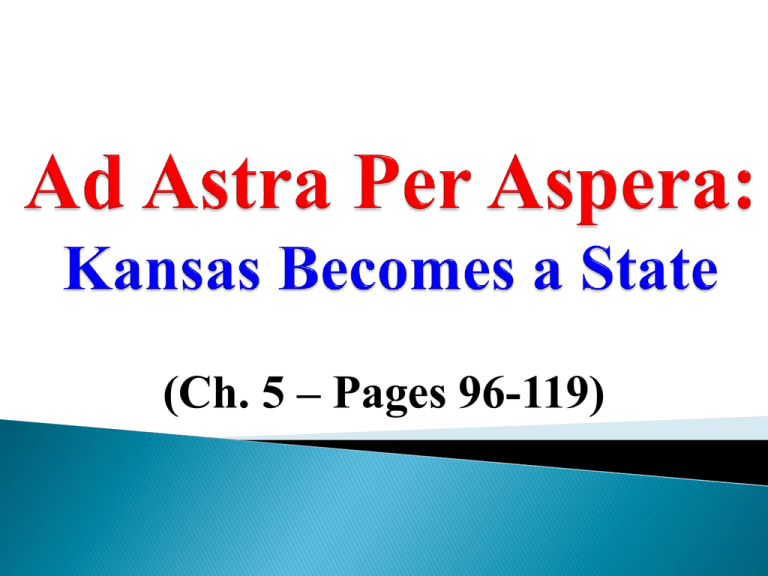
(Ch. 5 – Pages 96-119) 1861 – Kansas becomes a state and Topeka the capital 1861 - 1865 – The Civil War 1862 – James Lane recruits African-American soldiers for the First Colored Infantry 1863 – Quantrill and Confederates raid Lawrence 1864 – Battle of Mine Creek and Sand Creek Massacre 1866 – Construction on Capitol Building Begins 1867 – Medicine Peace Lodge Treaty Fort Atkinson was established 8 August 1850 Fort Aubrey was established early in September 1865 Fort Belmont was built about 1860 Fort Dodge was established April 10, 1865 Fort Harker was established in August of 1864 Fort hays was established October 11, 1865 Fort Larned was established October 22, 1859 Fort Mann was established in 1845 Fort Leavenworth, was established May 8, 1827 Fort Monument was established in Nov. of 1865 Jan. 29, 1861 - Kansas statehood begins State government based on Wyandotte Constitution Charles Robinson elected first governor “Kansas has been the testing ground for every experiment in morals, politics, and social life...every political fallacy nurtured by misfortune, poverty, and failure... has here found tolerance and advocacy... something startling has always happened, or has been constantly anticipated.” ~ John James Ingalls Proposed state motto and designed state seal (though seal was changed) as secretary of state Member of the 1859 Wyandotte Constitutional Convention Kansas State and U.S. Constitutions Kansas State Constitution Slavery Women’s Suffrage United States Constitution Bill of Rights prohibited slavery (1861) Did not prohibit slavery until 13th Amendment (1865) Women given right to vote in school board elections (1861) Did not allow women to vote until the 19th Amendment (1920) Populi Voce Nata “Born of the Popular Will” Seal of the Territory of Kansas Ad Astra Per Aspera “To the Stars Through Difficulty” Seal of the State of Kansas Landscape with a rising sun (the east). River and steamboat (commerce). Settler's cabin and a man plowing a field (agriculture). Wagons heading west (American expansion/pioneer life). Seal also shows Indians hunting buffalo, 34 stars (34th state to join Union) and the state motto (“Ad Astra Per Aspera”). Drouthy: thirsty or dry The artist Henry Worrall attempted to improve the image of Kansas as a dry and uninhabitable place What persuasive techniques did Worrall show in his painting? Ad Astra Per Aspera “To the Stars Through Difficulty” Wyandotte Constitution modeled after U.S. Constitution Document has Bill of Rights Inalienable - incapable of being alienated, surrendered or transferred Legislative Branch Makes and passes laws Two chambers: House of Representatives and Senate - 40 members who serve four-year terms House of Representatives - 125 members who Senate serve two-year terms Executive Branch Administer laws passed by legislature Headed by Governor who may serve up to two four-year terms Includes Lieutenant Governor, Secretary of State, Attorney General, State Treasurer and other agency directors Governor can approve or veto bills Judicial Branch Interpret laws and settle disputes between people Hear criminal cases where the state brings charges against a person State Supreme Court has 7 justices appointed by the governor A criminal case involves a crime. The court decides if a person is guilty and what punishment fits the crime. Remember – All people are innocent until proven guilty (It’s the American way) A civil case is between two parties that have a dispute over such things as money or property rights. Local governments include city and county government. Makes local laws called ordinances Makes sure federal, state and local laws are followed Provides important services, safe communities and a desirable place to live Federal (United States), State (Kansas), Local: County (Johnson County), City (Olathe) Charles Robinson 1st Governor of Kansas Sam Brownback 46th Governor of Kansas This media file is in the public domain in the United States. This applies to U.S. works where the copyright has expired, often because its first publication occurred prior to January 1, 1923. See this page for further explanation. Drought, failing crops and, in some areas, scarce drinking water No money in the state treasury, and state was in debt No guns or ammunition in state armory – a storehouse for arms Hostile border with proslavery Missouri Relief Committee – appealed to the government, churches and people to provide assistance to the starving people of Kansas Kansas Broadsides – advertisement or public notice printed on a large piece of paper Thad Allton/The CapitalJournal After a century of debate concerning the artwork at the Statehouse, the "Ad Astra" statue was placed on the Capitol dome in October. One month after Battle of Mine Creek Trail from Kansas to gold fields in Colorado ran through Cheyenne and Arapaho lands About 700 US volunteer soldiers attacked Cheyenne Chief Black Kettle’s camp, killing more than 150 Indians Led to further distrust between Indians and European Americans. Three treaties signed between the US Gov. and Indians on the plains - Cheyenne, Arapaho, Kiowa, Apache and Comanche at Medicine Lodge Creek, Kansas Plains Indians considered Medicine Lodge sacred area and the river to have healing powers US Gov. wanted peace with Plains Indians by having tribes live on reservations. But many Indians refused. US Gov. promised to protect Indians from whites and provide them with schools, farming tools and food Treaties opened up area for American settlement and the railroad Some tribes chose to live on reservations; others chose to remain free. Flew an American flag (given to him by Pres. Lincoln and a white flag from his tipi – but the signals were ignored Colorado forces killed 163 Cheyenne by shooting or stabbing. They burned down the village encampment. Most of the victims were women and children. For months afterward, members of the militia displayed trophies in Denver of their battle, including body parts they had taken for souvenirs Abolitionist Julia and her husband, Charles Lovejoy, a moved to Kansas Terr. in 1855 from New Hampshire as part of the New England Emigrant Aid Company Built the first house in Manhattan, later moved to Lawrence Diary and letters reveal what life was like during the territorial days of Kansas “My neighbors began to clear their houses of all their valuables, and secrete them in woods and cornfields. I caught a little tin trunk with our valuable papers and husband’s watch in it…and concealed it in tall weeds…Nearer and nearer they came.” ~ Lovejoy, who lived in Lawrence, describing William Quantrill’s raid on the town Just after midnight on Sept. 7, 1862, raiders under the command of William Quantrill attacked Olathe, killing several men and looting businesses and private homes This flag, apparently carried by one of the Confederate raiders, was dropped in Olathe. Kansas became a state less than three months before the Civil War started (Kansas statehood begins Jan. 29, 1861; the Civil War starts April 12, 1861) The Civil War (1861-1865) was fought between the Union (northern states) and the Confederacy (southern states) Most Kansans supported the Union (which they had just joined) and wanted the Union preserved, as did President Lincoln. Kansas had the highest death rate of any state in the Union (Nearly 8,500 of 20,000 volunteers in Kansas regiments died in Civil War battles One of Kansas’ first U.S. senators Lane organized Kansans into the Frontier Guard More than 100 Kansans provided special protection for President Lincoln “I have a hundred men from Kansas in this crowd, all armed, all fighting men, just from the victorious fields of Kansas!” ~ James Lane to Southerners who booed him in Washington D.C., showing his resolve to defend the nation’s capital after the outbreak of the Civil War Kansas Free state Union state Missouri Slave state (Missouri Compromise of 1820) Border state during Civil War Not a Confederate state (never seceded from the Union) but home to many Confederates and Southern sympathizers Battle fought between Union and Confederate forces at Mine Creek, where Union forces defeated Confederate General Sterling Price At least 200 Confederate soldiers died; Union troops also suffered causualties Self-portrait of Samuel Reader staking a claim in Kansas Territory. He came here for land, but stayed for the free-state cause. Fought with Union troops against Confederate troops led by Gen. Price; taken prisoner but escaped by posing as a Confederate Background “Order No. 11”: issued by Union patrolling the Kansas-Missouri border to clear all settlers out of four western Missouri counties image depicts the scene of William Quantrill's raid in 1863 August 21, 1863 Quantrill and 400 men raided Lawrence, KS. William C. Quantrill, Confederate guerilla At least 140 men and boys were killed and about a quarter of the town’s buildings burned. Comanche Chief who spoke at the Medicine Lodge Peace Treaties Abolitionist, sent letters to newspapers back east about Kansas Terr. She and her husband, Charles Haseltine Lovejoy, a preacher, moved in 1855 from New Hampshire to Kansas Terr. as part of the New England Emigrant Aid Company. oldest active army post west of the Mississippi River Served as first Kansas capital during territorial Kansas Protected wagons trains on the Santa Fe and Oregon-California Trails. Built to protect the expanding American frontier Troops protect workers building the Union Pacific Railroad Comanche Chief Ten Bears spoke at the Medicine Lodge Peace Treaties “The Comanches are not weak, and blind, like pups of a dog when seven sleeps old. They are strong and farsighted, like grown horses…But there are things which you have said to me which I do not like. They were not sweet like sugar, but bitter like gourds. You said that you wanted to put us upon reservations, to build us houses and to make us Medicine Lodges. I do not want them.” Source: Ten Bears, Yapparika Comanche Chief Public Domain Document I heard of your coming when I was many sleeps away I knew that you had come to do good to me and my people. I looked for the benefits which would last forever, and so my face shines with joy as I look upon you. My people have never first drawn a bow or fired a gun against the whites. It was you who sent out the first soldier, and it was we who sent out the second. blue dressed soldiers and the Utes came from out of the night when it was dark and still, and for campfires, they lit our lodges. Instead of hunting game, they killed my braves and the warriors of the tribe cut short their hair for the dead. The Comanches are not weak and blind like the pups of a dog when seven sleeps old. They are strong and farsighted like grown horses. We took their road and went on it. The white women cried, and our women laughed. But there are things which you have said to me which I did not like. They were not sweet like sugar, but bitter like gourds. You said that you wanted to put us on a reservation, to build us houses and to make us Medicine Lodges. I do not want them. I was born upon the prairie where the wind blew free, and there was nothing to break the light of the sun. I was born where there were no enclosures, and where everything drew free breath. I want to die there, and not within walls. I know every stream and every wood between the Rio Grande and the Arkansas. I have hunted and lived over the country. I lived like my fathers before me, and like them I lived happily. Do not ask us to give up the buffalo for the sheep. The young men have heard talk of this, and it has made them sad and angry. Do not speak of it any more. The white man has the country we loved and we only wish to wander on the prairie until we die. Any good thing you say to me shall not be forgotten. I shall carry it as near to my heart as my children, and it shall be as often on my tongue as the name of the Great Spirit. I want no blood upon my land to stain the grass. I want it all clear and pure, and I wish it so, that all who go through among my people may find peace when they come in, and leave it when they go out. - Ten Bears of the Yapparika Comanche


